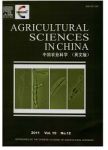The Application of ISSR Markers to Identify the Fertility Restorer Gene Rf6 in T. timopheevii Cytoplasmic MaleSterile Wheat(Triticum aestivum)
The Application of ISSR Markers to Identify the FertilityRestorer Gene Rf6 in *** Cytoplasmic MaleSterile Wheat(Triticum aestivum)作者机构:College of Crop Science China Agricultural University Beijing 100094 P.R.China College of Biology China Agricultural University Beijing 100094 P.R.China Institute of Genetics and Developmental Biology Chinese Academy of Sciences Beijing 100101 P.R.China
出 版 物:《Agricultural Sciences in China》 (中国农业科学(英文版))
年 卷 期:2002年第1卷第10期
页 面:1089-1093页
基 金:the National Natural Science Foundation of China(No.39893350) National High Technology Project"863"of China(No.2001AA241041)
主 题:Wheat Restorer gene Rf6 ISSR marker SSR marker
摘 要:Inter-simple sequence repeat (ISSR) analysis was carried out on a F2 population of 147 plants derived from a cross between a wheat male fertility restorer line 2114 and a male sterile line ND44A. Out of 43 primers examined, 18 primers produced distinguishable, polymorphic bands between the two parents. Linkage analysis in the mapping population showed that two markers UBC-808 and UBC-848 were closely linked with the restorer gene Rf6 of the Triticum timopheevii CMS system. The distance between the two markers and the restorer gene was 7.9 cM and 4.9 cM, respectively. Also two parents were screened with 181 pairs of SSR primers, of which, 34.3% showed polymorphisms. But no locus was found linked with the restorer gene. Compared with the SSR technique, the ISSR approach used in the experiment provided more information and proved to be a valuable method to identify alien fragments.



